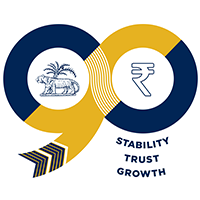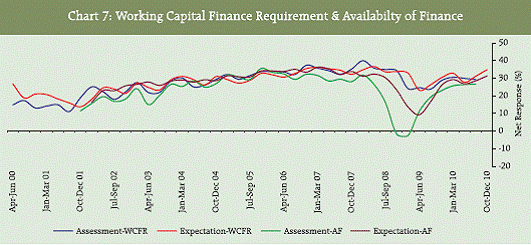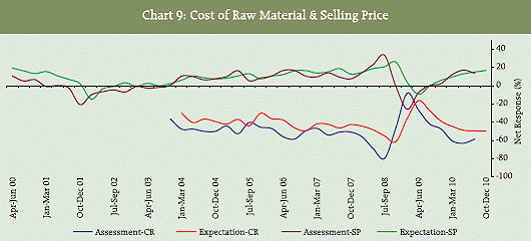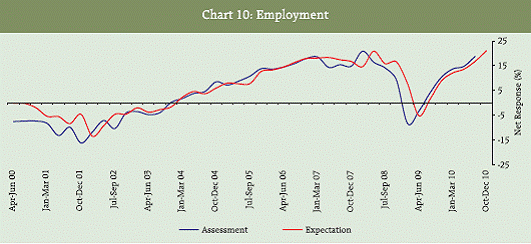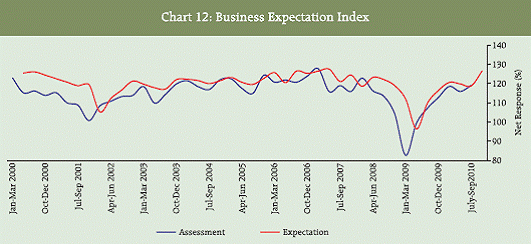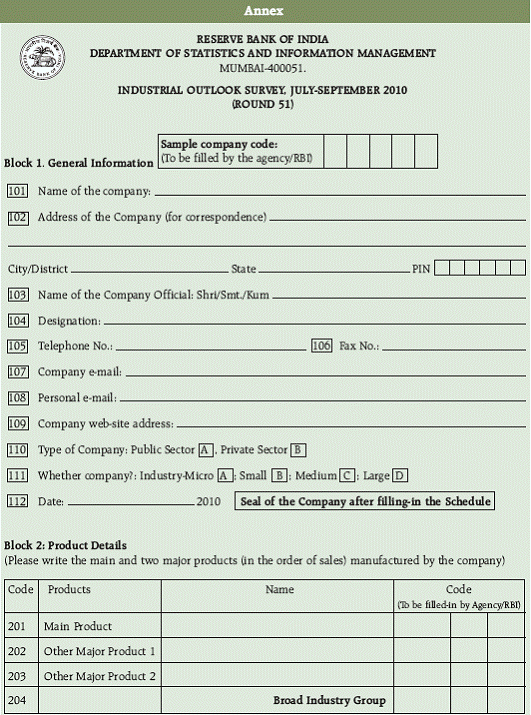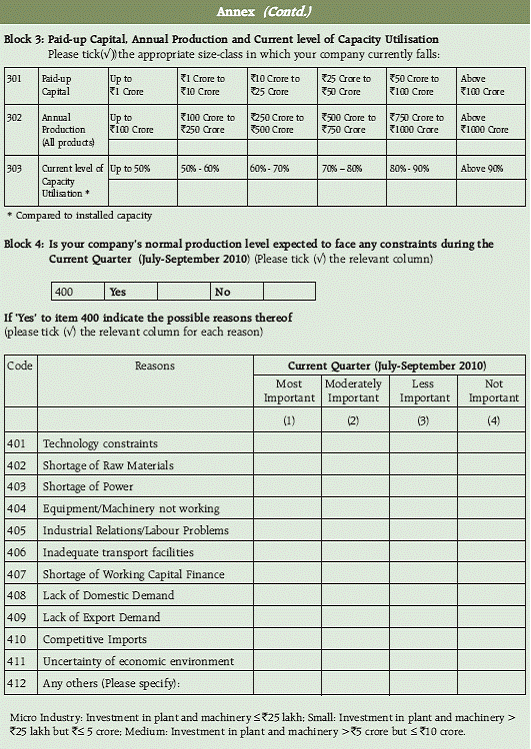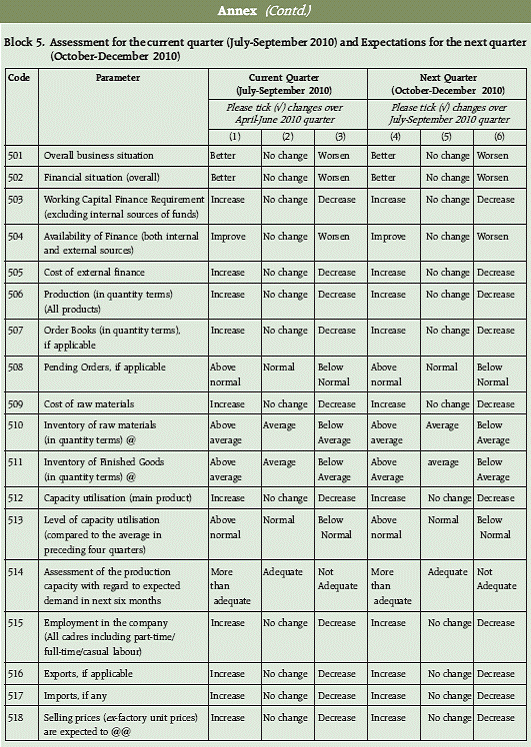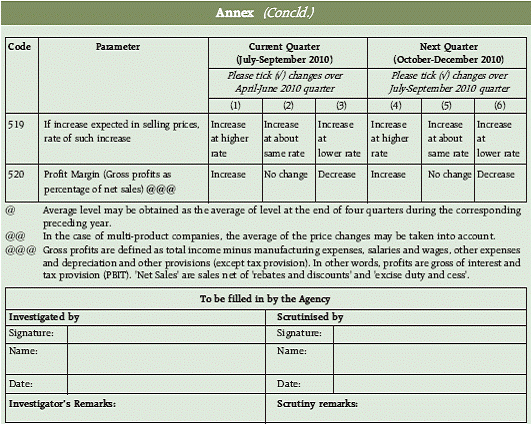Quarterly Industrial Outlook Survey: July- September 2010 (51st Round)* This article presents the findings of Industrial Outlook Survey conducted for July-September 2010 quarter, the 51st round in the series. It gives the assessment of business situation of companies in manufacturing sector, for the quarter July- September 2010, and their expectations for the ensuing quarter October-December 2010. The survey results signal that the Indian manufacturing sector took further steps of recovery pointing towards economic growth. Production and new business continued to grow markedly which is also reflected in the increase in work-force. The input price pressure eased noticeably and the manufacturers exhibit more optimism about their profits. The Business Expectation Index, which acts as a barometer of the overall health of the sector, posted 119.0 for the assessment quarter and 126.5 for the ensuing quarter – its highest reading since April-June 2007 quarter. Highlights The survey conducted in July- September 2010 shows that the business conditions in India’s manufacturing sector continued to strengthen with business conditions recuperating at a robust pace in both the quarters under review.
-
The demand conditions show signs of escalation during the current quarter. Indian manufacturers sharply raised production, primarily in order to accommodate a considerable increase in new business. Higher new order and production levels led Indian manufacturers to purchase more inputs and enlarge their stocks of raw materials and to increase capacity utilisation. The external market remained the prime impetus to growth, although the import market also played a part as its growth gained pace. A similar scenario is expected for the ensuing quarter as well.
-
The financial conditions slightly tightened for the current quarter as the optimism level for overall financial situation moderated during the assessment quarter, but the same is expected to improve for the forthcoming quarter. The manufacturers felt improvement in their working capital finance requirement and availability of finance for the current as well as the ensuing quarter. Inflationary pressure on the input prices is assessed to moderate which is getting reflected into the moderation in selling prices assessed for the current quarter. The profit margins are expected to improve in both the quarters. Employment scenario is also expected to improve in tune with the improvement in business conditions. However, the cost of external funds remained a great concern for the manufacturing sector.
-
The survey findings exhibit that the Indian manufacturing continued to gain strength at a robust pace as Business Expectation Index, both for the assessment quarter (July- September 2010) as well as expectations quarter (October-December 2010) increased to 119.0 and 126.5 from 115.9 and 118.8, respectively, as compared to the previous survey round (April- June 2010).
-
The industry-wise break-up shows that majority of the industry groups have positive overall business sentiments in the present quarter. Specifically a few industry groups, viz., Transport equipment, Electrical machinery, Pharmaceuticals & Medicines and Other Machinery & Apparatus are more optimistic than the others. Food Products, Cement and Wood & Wood Products expect low business performance in Q3 FY10.
-
Size-wise analysis shows that improvement is seen across all size groups, but the bigger companies are more optimistic and they expect high order book, building up of inventory and return of pricing power. Though the smaller companies (annual production less than ` 100 crore) have improved their performance, their growth is at a lower rate as compared to bigger companies.
I. Introduction The Reserve Bank of India has been conducting the Industrial Outlook Survey (IOS) on a quarterly basis since 1998. The Survey gives insight into the perception of the public and private limited companies engaged in manufacturing activities about their own performance and prospects. The survey covers select non-financial private and public limited companies with a good size/industry representation. The assessment of business sentiments for the current quarter and expectations for the ensuing quarter are based on qualitative responses on 20 major parameters covering overall business situation, financial situation, demand indicators, price and employment expectations, profit margins, etc. The survey provides useful forwardlooking inputs for policymakers, analysts and business alike. II. Data Coverage and Methodology1 II.1 Sample Size The sample covers about 3,000 nonfinancial public and private limited companies, mostly with paid-up capital above ` 50 lakh, in the manufacturing sector. The fieldwork for the survey was carried out during the two-month period ending August 2010. The panel of respondents is kept uniform to the extent possible except for periodic updation in the case of addition of new companies or deletion of closed/merged companies for having good size and industry-wise representation. II.2 Response to the Survey The survey elicited response from 1,425 companies (48 per cent of the sample) within the stipulated time. Companies with incomplete or improperly filled-in schedules were excluded for the analysis. The study is based on responses of 1,403 companies which were included in the analysis. II.3 The Survey Schedule The survey schedule consists of qualitative questions and the target respondents are senior management personnel or finance heads of the companies. The schedule, canvassed on quarterly basis, runs into two pages containing five blocks (Annex). III. Survey Findings The survey results are being published in a concise form in the Reserve Bank’s quarterly publication ‘Macroeconomic and Monetary Developments’ since 2005 and Monetary Policy statements. The survey findings of the 51 st round conducted for July-September 2010 quarter are presented in this article. III.1 Demand Conditions Survey collects perceptions of the Indian manufacturers about prominent demand related parameters, namely; Production, Order Books, Capacity Utilisation, Inventory, Exports and Imports. III.1.1 Production The questions on production seek the company’s assessment for July-September 2010 and expectations for October- December 2010 of Production (for all products), whether it will increase, decrease, or there will be no change. On the output front, the net response on production registered a significant increase as assessment and expectation for the corresponding quarters increased to 40.0 from 35.4 and to 49.1 from 40.2, respectively (Table 1 and Chart 1). The growth number shows that the demand conditions are once again back on track of escalation. Industrywise analysis shows that while Transport equipment and Diversified companies expected increase in production, Wood and wood product industry showed less optimism.
Table 1 : Assessment & Expectations for Production |
(Percentage responses)# |
Survey Quarter |
Total response |
Assessment for Current Quarter |
Expectation for Next Quarter |
Increase |
Decrease |
No change |
Net response |
Increase |
Decrease |
No change |
Net response |
1 |
2 |
3 |
4 |
5 |
6 |
7 |
8 |
9 |
10 |
Oct-Dec 08 |
1,178 |
36.0 |
24.9 |
39.1 |
11.1 |
48.8 |
9.0 |
42.1 |
39.8 |
Jan-Mar 09 |
1,225 |
27.1 |
35.1 |
37.7 |
-8.0 |
41.8 |
15.8 |
42.3 |
26.0 |
Apr-Jun 09 |
1,242 |
33.1 |
26.2 |
40.6 |
6.9 |
32.5 |
22.6 |
44.9 |
9.9 |
Jul-Sep 09 |
1,180 |
40.9 |
18.3 |
40.8 |
22.6 |
38.5 |
16.1 |
45.5 |
22.4 |
Oct-Dec 09 |
1,256 |
44.0 |
15.2 |
40.8 |
28.9 |
46.0 |
11.0 |
43.0 |
35.0 |
Jan-Mar 10 |
1,079 |
49.0 |
12.5 |
38.5 |
36.5 |
48.8 |
8.8 |
42.3 |
40.0 |
Apr-Jun 10 |
1,092 |
48.4 |
13.0 |
38.6 |
35.4 |
45.8 |
9.9 |
44.3 |
35.9 |
Jul-Sep 10 |
1,403 |
51.6 |
11.6 |
36.8 |
40.0 |
49.7 |
9.4 |
40.9 |
40.2 |
Oct-Dec 10 |
|
|
|
|
|
55.9 |
6.8 |
37.3 |
49.1 |
# The percentage responses may not add up to 100 due to rounding off. |
III.1.2 Order Books The demand position of the manufacturing companies, as directly measured by order books, has also shown a parallel trend. The net response, which moderated during the previous survey round, has reversed and has shown a sharp improvement in optimism level in the current survey quarter. The net response has increased to 36.1 from 31.3 per cent for the assessment quarter and to 44.8 from 36.3 for the ensuing quarter with respect to the previous survey round. (Table 2 and Chart 2). Transport equipment and Other machinery and apparatus industry are more optimistic about their order book level.
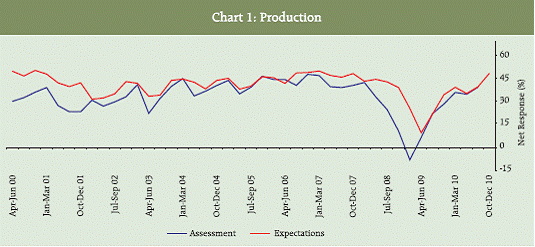 |
Table 2 : Assessment & Expectations for Order Books |
(Percentage responses)# |
Survey Quarter |
Total response |
Assessment for Current Quarter |
Expectation for Next Quarter |
Increase |
Decrease |
No change |
Net response |
Increase |
Decrease |
No change |
Net response |
1 |
2 |
3 |
4 |
5 |
6 |
7 |
8 |
9 |
10 |
Oct-Dec 08 |
1,178 |
32.6 |
25.1 |
42.2 |
7.5 |
44.8 |
9.1 |
46.1 |
35.7 |
Jan-Mar 09 |
1,225 |
22.9 |
39.7 |
37.4 |
-16.8 |
37.3 |
16.7 |
46.1 |
20.6 |
Apr-Jun 09 |
1,242 |
28.4 |
29.3 |
42.3 |
-0.9 |
31.0 |
24.6 |
44.4 |
6.4 |
Jul-Sep 09 |
1,180 |
38.2 |
17.7 |
44.1 |
20.5 |
35.5 |
18.7 |
45.8 |
16.8 |
Oct-Dec 09 |
1,256 |
39.5 |
13.6 |
46.8 |
25.9 |
43.5 |
11.2 |
45.3 |
32.3 |
Jan-Mar 10 |
1,079 |
43.5 |
11.6 |
44.9 |
31.9 |
44.8 |
9.1 |
46.1 |
35.8 |
Apr-Jun 10 |
1,092 |
41.8 |
10.5 |
47.7 |
31.3 |
42.3 |
8.9 |
48.8 |
33.4 |
Jul-Sep 10 |
1,403 |
45.4 |
9.3 |
45.3 |
36.1 |
44.4 |
8.1 |
47.5 |
36.3 |
Oct-Dec 10 |
|
|
|
|
|
49.8 |
5.1 |
45.1 |
44.8 |
# The percentage responses may not add up to 100 due to rounding off. |
III.1.3. Pending Orders One question was asked to the manufacturing companies to seek information whether pending orders for current and next quarter will be above normal, normal or below normal. It is seen that the optimism level for maintaining pending order (i.e., ‘below normal’) for assessment quarter has decreased further. The net response for current as well as for ensuing quarters has also decreased further (Table 3 and Chart 3). III.1.4 Capacity Utilisation The survey has three questions on capacity utilisation, which is the extent to which an enterprise actually uses its installed capacity. It collects views of manufacturing companies about Capacity Utilisation of main product (increase/ decrease/no change), Level of capacity utilisation compared to the average in the last four quarters (above normal/below normal/normal) and Assessment of production capacity with regard to expected demand in next six months (more than adequate/less than adequate/adequate).
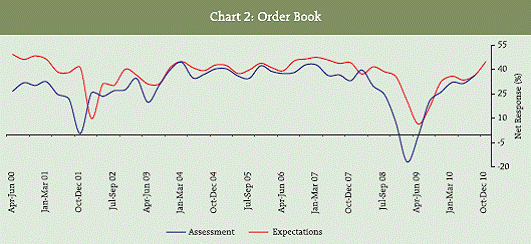 |
More companies reported an increase in capacity utilisation as compared to previous quarter, indicating improvement in Capacity Utilisation, and this level of capacity utilisation is above normal as seen in the context of capacity level attained in the last four quarters. The expectation for the next quarter also exhibited a similar sentiment. Assessment of Production capacity with regard to expected demand in next six months shows that there will be adequate capacity as proportion of companies that reponed adequate production capacity in meeting the demand for the next 6 months has moved up (Table 4 and Chart 4). While Transport equipment and Diversified companies expected increase in their capacity utilisation, Wood and wood product and Cement industry showed less optimism.
Table 3 : Assessment & Expectations for Pending Orders |
(Percentage responses)# |
Survey Quarter |
Total response |
Assessment for Current Quarter |
Expectation for Next Quarter |
Below Normal |
Above Normal |
Normal |
Net response |
Below Normal |
Above Normal |
Normal |
Net response |
1 |
2 |
3 |
4 |
5 |
6 |
7 |
8 |
9 |
10 |
Oct-Dec 08 |
1,178 |
19.2 |
5.6 |
75.2 |
13.6 |
11.3 |
6.7 |
82.0 |
4.6 |
Jan-Mar 09 |
1,225 |
36.3 |
4.3 |
59.4 |
32.0 |
16.9 |
5.4 |
77.8 |
11.5 |
Apr-Jun 09 |
1,242 |
29.1 |
4.5 |
66.5 |
24.6 |
28.0 |
4.8 |
59.4 |
23.2 |
Jul-Sep 09 |
1,180 |
21.1 |
3.7 |
75.2 |
17.4 |
22.9 |
3.8 |
73.4 |
19.1 |
Oct-Dec 09 |
1,256 |
17.1 |
5.6 |
77.3 |
11.6 |
15.2 |
4.2 |
80.6 |
11.0 |
Jan-Mar 10 |
1,079 |
15.5 |
6.7 |
77.8 |
8.8 |
12.2 |
6.5 |
81.3 |
5.7 |
Apr-Jun 10 |
1,092 |
14.3 |
7.4 |
78.3 |
6.9 |
12.9 |
6.4 |
80.7 |
6.5 |
Jul-Sep 10 |
1,403 |
12.0 |
6.9 |
81.1 |
5.1 |
11.4 |
7.3 |
81.3 |
4.2 |
Oct-Dec 10 |
|
|
|
|
|
8.8 |
7.3 |
83.9 |
1.5 |
# The percentage responses may not add up to 100 due to rounding off. |
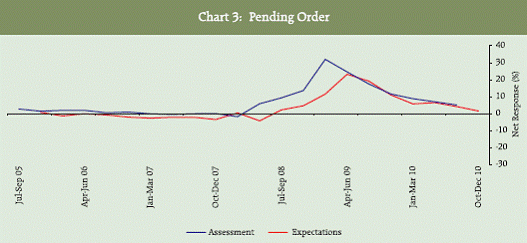 |
Table 4 : Per cent Responses on Sentiments for Capacity Utilisation |
(Percentage responses) # |
Parameter |
Options |
Assessment for quarter |
Expectations for quarter |
Apr-June 2010 |
Jul-Sep 2010 |
Jul-Sep 2010 |
Oct-Dec 2010 |
1 |
2 |
3 |
4 |
5 |
6 |
Capacity Utilisation (main product) |
Increase |
33.5 |
34.7 |
35.3 |
38.9 |
No Change |
54.2 |
53.9 |
56.0 |
54.5 |
Decrease |
12.3 |
11.4 |
8.7 |
6.6 |
Net Response |
21.1 |
23.3 |
26.5 |
32.3 |
Level of Capacity Utilisation (compared to the average in last 4 quarters) |
Above normal |
15.7 |
14.8 |
14.8 |
15.5 |
Normal |
71.1 |
73.6 |
76.2 |
76.3 |
Below Normal |
13.2 |
11.7 |
9.0 |
8.3 |
Net Response |
2.5 |
3.1 |
5.8 |
7.2 |
Assessment of Production Capacity (with regard to expected demand in next 6 months) |
More than adequate |
10.6 |
11.2 |
10.6 |
12.4 |
Adequate |
81.8 |
80.8 |
82.9 |
80.7 |
Less than adequate |
7.6 |
8.0 |
6.5 |
6.9 |
Net Response |
3.1 |
3.3 |
4.1 |
5.6 |
# The percentage responses may not add up to 100 due to rounding off. |
III.1.5 Inventory of Raw Materials & Finished Goods Majority of the respondents (80-85 per cent) reported average level of Inventory of raw materials and Inventory of finished goods for the current quarter as well as ensuing quarter. While around 10 per cent of the respondents expect to witness an increase in their inventory levels during October- December 2010 quarter, only 5-7 per cent of the respondents expect their level of stock to decline. The net response for Inventory Levels for raw materials and finished goods is presented in Table 5. It is observed that Indian corporate sector witnesses inventory build-up during high demand conditions.
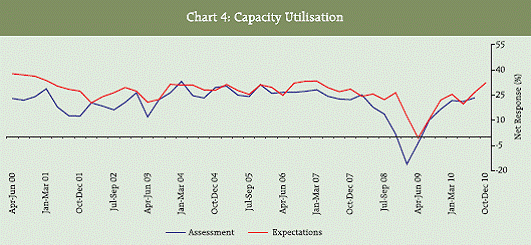 |
Table 5 : Assessment & Expectations for Level of Inventory (Raw Material and Finished Goods) |
(Percentage responses)# |
Parameter |
Options |
Assessment for quarter |
Expectations for quarter |
Apr-Jun 2010 |
Jul-Sep 2010 |
Jul-Sep 2010 |
Oct-Dec 2010 |
1 |
2 |
3 |
4 |
5 |
6 |
Inventory of raw material |
Below average |
7.3 |
6.4 |
5.3 |
3.8 |
Average |
80.4 |
81.9 |
84.4 |
85.8 |
Above average |
12.3 |
11.7 |
10.3 |
10.4 |
Net Response |
-5.0 |
-5.3 |
-5.1 |
-6.6 |
Inventory of Finished goods |
Below average |
6.5 |
7.4 |
5.0 |
5.8 |
Average |
82.8 |
81.0 |
85.1 |
85.7 |
Above average |
10.7 |
11.7 |
9.9 |
8.6 |
Net Response |
-4.1 |
-4.3 |
-5.0 |
-2.8 |
Below average is optimistic.
# The percentage responses may not add up to 100 due to rounding off. |
III.1.6 Exports and Imports The external and internal demand of manufacturing companies is gauged by the survey through their assessment and expectation on Exports and Imports. The companies report their perceptions on these two parameters in the form: increase, no change and decrease. The survey results show the exports of the manufacturing sector in India grew robustly in the current quarter. The net response for the current quarter has increased to 20.0 per cent from 15.3 per cent in previous quarter. The Indian manufactures also expect strong growth in the external demand for the forthcoming quarter as the net response increased to 26.1 per cent from 20.7 per cent in the previous quarter (Table 6). Pharmaceutical & Medicines and Transport equipment are more optimistic about their external demand.
Table 6 : Assessment & Expectations for Exports |
(Percentage responses)# |
Survey Quarter |
Total response |
Assessment for Current Quarter |
Expectation for Next Quarter |
Increase |
Decrease |
No change |
Net response |
Increase |
Decrease |
No change |
Net response |
1 |
2 |
3 |
4 |
5 |
6 |
7 |
8 |
9 |
10 |
Oct-Dec 08 |
1,178 |
27.6 |
20.0 |
52.4 |
7.6 |
36.5 |
9.2 |
54.3 |
27.3 |
Jan-Mar 09 |
1,225 |
17.8 |
34.8 |
47.4 |
-17.0 |
30.6 |
14.6 |
54.8 |
16.0 |
Apr-Jun 09 |
1,242 |
17.4 |
30.9 |
51.7 |
-13.5 |
19.5 |
23.3 |
57.3 |
-3.8 |
Jul-Sep 09 |
1,180 |
20.9 |
23.8 |
55.3 |
-2.9 |
20.6 |
20.5 |
59.0 |
0.1 |
Oct-Dec 09 |
1,256 |
27.3 |
18.1 |
54.6 |
9.2 |
27.0 |
14.5 |
58.5 |
12.5 |
Jan-Mar 10 |
1,079 |
28.9 |
16.2 |
54.9 |
12.7 |
31.2 |
11.0 |
57.8 |
20.2 |
Apr-Jun 10 |
1,092 |
29.1 |
13.7 |
57.2 |
15.3 |
30.0 |
11.5 |
58.5 |
18.5 |
Jul-Sep 10 |
1,403 |
31.8 |
11.8 |
56.5 |
20.0 |
30.8 |
10.1 |
59.1 |
20.7 |
Oct-Dec 10 |
|
|
|
|
|
34.4 |
8.3 |
57.3 |
26.1 |
# The percentage responses may not add up to 100 due to rounding off. |
Table 7 : Assessment & Expectations for Imports |
(Percentage responses)# |
Survey Quarter |
Total response |
Assessment for Current Quarter |
Expectation for Next Quarter |
Increase |
Decrease |
No change |
Net response |
Increase |
Decrease |
No change |
Net response |
1 |
2 |
3 |
4 |
5 |
6 |
7 |
8 |
9 |
10 |
Oct-Dec 08 |
1,178 |
20.2 |
13.5 |
66.3 |
6.7 |
26.7 |
5.3 |
67.9 |
21.4 |
Jan-Mar 09 |
1,225 |
13.7 |
22.1 |
64.2 |
-8.4 |
19.7 |
10.6 |
69.7 |
9.1 |
Apr-Jun 09 |
1,242 |
17.1 |
18.4 |
64.5 |
-1.3 |
14.9 |
16.3 |
68.8 |
-1.4 |
Jul-Sep 09 |
1,180 |
21.8 |
14.0 |
64.2 |
7.8 |
17 |
12.4 |
70.6 |
4.6 |
Oct-Dec 09 |
1,256 |
23.3 |
10.3 |
66.5 |
13.0 |
21.3 |
9.8 |
68.9 |
11.5 |
Jan-Mar 10 |
1,079 |
25.5 |
8.4 |
66.1 |
17.1 |
23.4 |
6.5 |
70.1 |
16.9 |
Apr-Jun 10 |
1,092 |
27.7 |
6.8 |
65.6 |
20.9 |
22.9 |
5.9 |
71.2 |
17.1 |
Jul-Sep 10 |
1,403 |
28.6 |
6.6 |
64.7 |
22.0 |
27.0 |
5.4 |
67.6 |
21.7 |
Oct-Dec 10 |
|
|
|
|
|
27.3 |
5.1 |
67.6 |
22.2 |
# The percentage responses may not add up to 100 due to rounding off. |
The survey reveals moderate growth in the optimism of the manufacturing sector in terms of demand for import. The net response on assessment and expectation for Import is in the growth terrain though at a low rate. The sentiments have increased moderately from the preceding rounds for both the quarters under review (22.0 per cent for the assessment and 22.2 for expectation quarters respectively, Table 7). Electrical machinery and Pharmaceutical and medicine are the sectors that are more optimistic on their import demand. The movements in the sentiments for exports and imports are presented in Chart 5. III.2 Financial Situation The survey assesses sentiments about financial conditions through five parameters, viz., Overall Financial Situation, Working Capital Finance Requirement (excluding internal sources of funds), Availability of Finance (both internal and external sources), Cost of External Finance and Profit Margin.
 |
Table 8 : Assessment & Expectations for Overall Financial Situation |
(Percentage responses)# |
Survey Quarter |
Total response |
Assessment for Current Quarter |
Expectation for Next Quarter |
Better |
Worsen |
No change |
Net response |
Better |
Worsen |
No change |
Net response |
1 |
2 |
3 |
4 |
5 |
6 |
7 |
8 |
9 |
10 |
Oct-Dec 08 |
1,178 |
22.0 |
24.9 |
53.1 |
-2.9 |
37.6 |
9.9 |
52.5 |
27.7 |
Jan-Mar 09 |
1,225 |
20.3 |
29.9 |
49.9 |
-9.6 |
31.6 |
15.2 |
53.2 |
16.4 |
Apr-Jun 09 |
1,242 |
26.4 |
19.4 |
54.2 |
7.0 |
27.8 |
19.4 |
52.7 |
8.4 |
Jul-Sep 09 |
1,180 |
34.3 |
12.5 |
53.2 |
21.8 |
32.8 |
12.8 |
54.4 |
20.0 |
Oct-Dec 09 |
1,256 |
38.8 |
9.3 |
51.8 |
29.5 |
40.5 |
7.0 |
52.5 |
33.5 |
Jan-Mar 10 |
1,079 |
42.3 |
6.5 |
51.3 |
35.8 |
44.3 |
5.0 |
50.6 |
39.3 |
Apr-Jun 10 |
1,092 |
39.1 |
6.9 |
54.0 |
32.2 |
41.6 |
5.3 |
53.1 |
36.3 |
Jul-Sep 10 |
1,403 |
38.7 |
8.1 |
53.2 |
30.6 |
39.7 |
5.6 |
54.8 |
34.1 |
Oct-Dec 10 |
|
|
|
|
|
44.9 |
5.3 |
49.7 |
39.6 |
# : The percentage responses may not add up to 100 due to rounding off. |
III.2.1 Overall Financial Situation The financial conditions, though moderated slightly, continued to be buoyant, in the current survey quarter as the net response on the assessment quarter under review declined to 30.6 per cent from 32.2 per cent. However, the manufacturers expect a rise in their overall financial situation for the ensuing quarter (October- December 2010) as the net response registered a marginal rise to 39.6 per cent from 34.1 per cent. Chart 6 reveals the trend that exhibits the optimism level on Overall Financial Situation. Amongst all the industry groups, Cement industry is least optimistic about their Overall Financial Situation. III.2.2 Working Capital Finance Requirement and Availability of Finance The assessment on the Working capital finance requirement (excluding internal source of funds) for the assessment quarter (July-September 2010) continued to be optimistic albeit at lower level with net response moving to 29.3 per cent from 29.9 per cent. However, the expectation on the same shows an improvement as the net response registered an increase (34.8 per cent from 31.1 per cent (Table 9)).
 |
Table 9 : Assessment & Expectations for Working Capital Finance Requirement |
(Percentage responses)# |
Survey Quarter |
Total response |
Assessment for Current Quarter |
Expectation for Next Quarter |
Increase |
Decrease |
No change |
Net response |
Increase |
Decrease |
No change |
Net response |
1 |
2 |
3 |
4 |
5 |
6 |
7 |
8 |
9 |
10 |
Oct-Dec 08 |
1,178 |
41.1 |
6.8 |
52.1 |
34.3 |
38.1 |
4.3 |
57.7 |
33.8 |
Jan-Mar 09 |
1,225 |
36.0 |
11.9 |
52.1 |
24.1 |
37.9 |
5.0 |
57.1 |
32.9 |
Apr-Jun 09 |
1,242 |
57.0 |
24.6 |
9.2 |
24.6 |
31.1 |
7.9 |
61.0 |
23.2 |
Jul-Sep 09 |
1,180 |
31.2 |
7.4 |
61.4 |
23.8 |
32.3 |
6.0 |
61.7 |
26.3 |
Oct-Dec 09 |
1,256 |
35.2 |
6.4 |
58.4 |
28.8 |
34.7 |
4.3 |
61.0 |
30.4 |
Jan-Mar 10 |
1,079 |
35.8 |
5.3 |
58.9 |
30.5 |
36.8 |
4.0 |
59.2 |
32.7 |
Apr-Jun 10 |
1,092 |
34.7 |
4.8 |
60.5 |
29.9 |
31.9 |
4.3 |
63.8 |
27.7 |
Jul-Sep 10 |
1,403 |
35.6 |
6.3 |
58.1 |
29.3 |
35.2 |
4.1 |
60.7 |
31.1 |
Oct-Dec 10 |
|
|
|
|
|
38.4 |
3.6 |
58.0 |
34.8 |
# The percentage responses may not add up to 100 due to rounding off. |
The survey shows that the percentage of respondents who viewed improvement in Availability of Finance has improved marginally. This is well-echoed in the net optimism as well, as the net optimism has been enhanced for both the quarters under review (Table 10). The quarterly movements of Working Capital Finance Requirements (WCFR) and Availability of Finance (both internal and external sources), presented in the Chart 7 below, shows that for the ensuing quarter, the manufacturers expect their WCFR and availability of finance to improve further compared to previous quarter. While Rubber and Plastic product industry show more optimism on Working Capital Finance Requirements, Diversified companies and Transport equipment exhibited more optimism on the Availability of Finance.
Table 10: Assessment & Expectations for Availability of Finance |
(Percentage responses)# |
Survey Quarter |
Total response |
Assessment for Current Quarter |
Expectation for Next Quarter |
Improve |
Worsen |
No change |
Net response |
Improve |
Worsen |
No change |
Net response |
1 |
2 |
3 |
4 |
5 |
6 |
7 |
8 |
9 |
10 |
Oct-Dec 08 |
1,178 |
21.4 |
23.1 |
55.5 |
-1.7 |
32.1 |
8.8 |
59.0 |
23.3 |
Jan-Mar 09 |
1,225 |
19.2 |
21.7 |
59.1 |
-2.5 |
28.7 |
15.0 |
56.3 |
13.7 |
Apr-Jun 09 |
1,242 |
24.8 |
13.6 |
61.6 |
11.2 |
23.8 |
14.5 |
61.7 |
9.3 |
Jul-Sep 09 |
1,180 |
28.0 |
8.8 |
63.2 |
19.2 |
27.0 |
10.4 |
62.6 |
16.6 |
Oct-Dec 09 |
1,256 |
30.3 |
7.2 |
62.5 |
23.0 |
31.7 |
5.6 |
62.7 |
26.1 |
Jan-Mar 10 |
1,079 |
32.1 |
6.4 |
61.5 |
25.7 |
33.7 |
4.5 |
61.8 |
29.2 |
Apr-Jun 10 |
1,092 |
32.3 |
5.9 |
61.8 |
26.4 |
31.2 |
4.4 |
64.4 |
26.8 |
Jul-Sep 10 |
1,403 |
32.6 |
6.0 |
61.4 |
26.6 |
32.9 |
4.4 |
62.7 |
28.5 |
Oct-Dec10 |
|
|
|
|
|
35.3 |
4.0 |
60.6 |
31.3 |
# The percentage responses may not add up to 100 due to rounding off. |
III.2.3 Cost of External Finance The cost of external finance was included in the survey schedule from Round 48 (October-December 2009) onwards. The respondents are asked to express their opinion on a three point scale viz., Increase/ Decrease/No change about their perceptions of cost of funds. The survey result reveals that the respondents are notably concerned about the increase in the cost of external fund. The net response on the cost of external finance for both the quarters under review is presented in Table 11. III.2.4 Profit Margin Survey asks manufacturing companies whether, in their opinion, profit margin (gross profits as percentage to net sales) is expected to increase, decrease or remain the same. The sentiments on Profit margin for the current quarter of the survey, though improved, are still in the negative terrain (Table 12). However, the extent of pessimism has declined compared to preceding quarter. The sentiments on expectation for the ensuing quarter have improved sharply to 9.2 per cent from 3.1 per cent (Chart 8). Diversified industry anticipate improvement in their profit margin as compared to the other industry groups.
Table 11 : Assessment & Expectations for Cost of External Finance |
(Percentage responses)# |
Survey Quarter |
Total response |
Assessment for Current Quarter |
Expectation for Next Quarter |
Increase |
Decrease |
No change |
Net response |
Increase |
Decrease |
No change |
Net response |
1 |
2 |
3 |
4 |
5 |
6 |
7 |
8 |
9 |
10 |
Oct-Dec 09 |
1,256 |
9.0 |
23.8 |
67.2 |
-14.7 |
|
|
|
|
Jan-Mar 10 |
1,079 |
7.7 |
23.6 |
68.7 |
-15.9 |
6.8 |
25.1 |
68.1 |
-18.3 |
Apr-Jun 10 |
1,092 |
7.0 |
28.9 |
64.0 |
-21.9 |
6.1 |
26.8 |
67.1 |
-20.6 |
Jul-Sep 10 |
1,403 |
5.0 |
33.2 |
61.8 |
-28.3 |
5.7 |
29.0 |
65.3 |
-23.3 |
Oct-Dec 10 |
|
|
|
|
|
3.8 |
32.1 |
64.2 |
-28.3 |
# The percentage responses may not add up to 100 due to rounding off. |
Table 12 : Assessment & Expectations for Profit Margin |
(Percentage responses)# |
Survey Quarter |
Total response |
Assessment for Current Quarter |
Expectation for Next Quarter |
Increase |
Decrease |
No change |
Net response |
Increase |
Decrease |
No change |
Net response |
1 |
2 |
3 |
4 |
5 |
6 |
7 |
8 |
9 |
10 |
Oct-Dec 08 |
1,178 |
14.4 |
41.0 |
44.6 |
-26.6 |
20.8 |
24.4 |
54.7 |
-3.6 |
Jan-Mar 09 |
1,225 |
11.3 |
48.8 |
39.8 |
-37.5 |
16.9 |
29.8 |
53.3 |
-12.9 |
Apr-Jun 09 |
1,242 |
13.4 |
38.5 |
48.1 |
-25.1 |
15.4 |
34.0 |
50.6 |
-18.6 |
Jul-Sep 09 |
1,180 |
16.9 |
32.0 |
51.1 |
-15.1 |
16.0 |
29.4 |
54.5 |
-13.4 |
Oct-Dec 09 |
1,256 |
18.1 |
28.0 |
54.0 |
-9.9 |
20.2 |
23.0 |
56.8 |
-2.8 |
Jan-Mar 10 |
1,079 |
21.7 |
24.6 |
53.9 |
-2.9 |
21.1 |
20.1 |
58.8 |
1.1 |
Apr-Jun 10 |
1,092 |
20.2 |
25.0 |
54.9 |
-4.8 |
22.1 |
18.9 |
59.0 |
3.2 |
Jul-Sep 10 |
1,403 |
21.3 |
23.9 |
54.8 |
-2.5 |
22.2 |
19.1 |
58.7 |
3.1 |
Oct-Dec 10 |
|
|
|
|
|
25.2 |
16.1 |
58.7 |
9.2 |
# The percentage responses may not add up to 100 due to rounding off. |
III.3 Price and Employment Expectation Prices-related three questions were canvassed in the survey. The questions sought increase, decrease or no change in the Cost of Raw Material. III.3.1. Cost of Raw Material The survey reveals that the pressure that prevailed in the input cost of raw material has reduced marginally as compared to the preceding quarter (Table 13). The net response on cost of raw material of the reporting companies improved in the current quarter and it remained same for the ensuing quarter. Specifically, Other industry and Wood and wood products industry anticipate more pressure on their input cost.
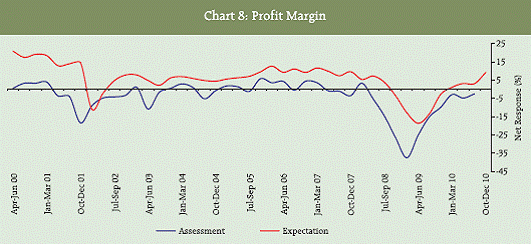 |
Table 13 : Assessment & Expectations for Cost of Raw Material |
(Percentage responses)# |
Survey Quarter |
Total response |
Assessment for Current Quarter |
Expectation for Next Quarter |
Decrease |
Increase |
No change |
Net response |
Decrease |
Increase |
No change |
Net response |
1 |
2 |
3 |
4 |
5 |
6 |
7 |
8 |
9 |
10 |
Oct-Dec 08 |
1,178 |
14.1 |
60.1 |
25.8 |
-46.0 |
3.3 |
64.4 |
32.3 |
-61.1 |
Jan-Mar 09 |
1,225 |
29.1 |
37.2 |
33.7 |
-8.1 |
12.3 |
48.0 |
39.7 |
-35.7 |
Apr-Jun 09 |
1,242 |
14.3 |
40.6 |
45.1 |
-26.3 |
14.3 |
30.5 |
33.7 |
-16.2 |
Jul-Sep 09 |
1,180 |
8.1 |
49.8 |
42.1 |
-41.7 |
8.7 |
35.8 |
55.5 |
-27.1 |
Oct-Dec 09 |
1,256 |
6.3 |
53.4 |
40.3 |
-47.1 |
5.0 |
43.4 |
51.6 |
-38.4 |
Jan-Mar 10 |
1,079 |
2.2 |
62.3 |
35.5 |
-60.2 |
3.6 |
47.9 |
48.5 |
-44.3 |
Apr-Jun 10 |
1,092 |
2.5 |
65.2 |
32.3 |
-62.7 |
2.2 |
50.8 |
47.0 |
-48.6 |
Jul-Sep 10 |
1,403 |
3.5 |
61.8 |
34.7 |
-58.3 |
2.7 |
52.0 |
45.2 |
-49.3 |
Oct-Dec 10 |
|
|
|
|
|
3.3 |
52.6 |
44.1 |
-49.3 |
# The percentage responses may not add up to 100 due to rounding off. |
III.3.2 Selling Price Survey seeks responses on Selling Prices (ex-factory unit prices); and if there was an increase expected in Selling Prices, enquiries are made about the rate of increase in the Selling Prices (at higher/ lower/similar rate) from manufacturing corporate. In case of multi-product companies, they are requested to take into account the average of the price changes. Optimism level for Selling prices (‘increase in selling price’) for the current quarter moderated marginally. While 28.0 per cent corporates indicated an increase in the selling prices in the current quarter, 25.7 per cent expected this increase to continue for the ensuing quarter (Table 14). The net response, though, exhibited a minor turndown in the current quarter; the same has shown increase in the ensuing quarter. The movement of input and output prices is presented in Chart 9. Amongst the sectors, Diversified companies are more optimistic about their output prices.
Table 14 : Assessment & Expectations for Selling Price |
(Percentage responses)# |
Survey Quarter |
Total response |
Assessment for Current Quarter |
Expectation for Next Quarter |
Increase |
Decrease |
No change |
Net response |
Increase |
Decrease |
No change |
Net response |
1 |
2 |
3 |
4 |
5 |
6 |
7 |
8 |
9 |
10 |
Oct-Dec 08 |
1,178 |
23.2 |
23.7 |
53.1 |
-0.5 |
34.3 |
8.1 |
57.6 |
26.2 |
Jan-Mar 09 |
1,225 |
12.5 |
38.0 |
49.5 |
-25.5 |
21.2 |
17.1 |
61.7 |
4.1 |
Apr-Jun 09 |
1,242 |
17.0 |
24.4 |
58.0 |
-7.4 |
14.5 |
23.6 |
61.9 |
-9.1 |
Jul-Sep 09 |
1,180 |
19.4 |
19.2 |
61.4 |
0.2 |
17.2 |
17.2 |
65.6 |
0.0 |
Oct-Dec 09 |
1,256 |
18.6 |
15.9 |
65.5 |
2.6 |
19.2 |
13.2 |
67.6 |
6.0 |
Jan-Mar 10 |
1,079 |
24.6 |
12.2 |
63.2 |
12.4 |
20.7 |
10.9 |
68.4 |
9.8 |
Apr-Jun 10 |
1,092 |
29.3 |
12.0 |
58.6 |
17.3 |
22.4 |
9.1 |
68.5 |
13.3 |
Jul-Sep 10 |
1,403 |
28.0 |
14.2 |
57.8 |
13.8 |
24.4 |
9.2 |
66.3 |
15.2 |
Oct-Dec 10 |
|
|
|
|
|
25.7 |
8.7 |
65.5 |
17.0 |
# The percentage responses may not add up to 100 due to rounding off. |
III.3.3 Employment The Survey seeks from the companies their perceptions on change in employment at their company. Employment includes all cadres comprising full-time, part-time and casual labour. The employment scenario of Indian manufacturing exhibits robust recovery in the current quarter (July- September 2010) with sharp increase in net response to 18.7 per cent from 14.7 per cent (Table 15, Chart 10).The expectations on employment outlook for the October- December 2010 quarter has also shown solid escalation with only 3.6 per cent of the respondents expecting a decline in number of employees. While as many as 24.7 per cent of the respondents anticipate an increase in number of employees during Q3 2010, a majority (71.7 per cent) of the respondents intend to keep the number of employees unchanged. Among the industry groups, Diversified companies and Rubber and plastic products shows a greater inclination towards increasing the number of employees.
Table 15 : Assessment & Expectations for Employment Outlook |
(Percentage responses)# |
Survey Quarter |
Total response |
Assessment for Current Quarter |
Expectation for Next Quarter |
Increase |
Decrease |
No change |
Net response |
Increase |
Decrease |
No change |
Net response |
1 |
2 |
3 |
4 |
5 |
6 |
7 |
8 |
9 |
10 |
Oct-Dec 08 |
1,178 |
18.7 |
9.3 |
72.0 |
9.4 |
23.1 |
6.5 |
70.4 |
16.6 |
Jan-Mar 09 |
1,225 |
11.2 |
19.5 |
69.3 |
-8.3 |
16.0 |
8.3 |
75.7 |
7.7 |
Apr-Jun 09 |
1,242 |
11.9 |
15.2 |
72.9 |
-3.3 |
10.5 |
15.6 |
74.0 |
-5.1 |
Jul-Sep 09 |
1,180 |
14.2 |
10.1 |
75.7 |
4.1 |
11.5 |
10.0 |
78.6 |
1.5 |
Oct-Dec 09 |
1,256 |
18.2 |
7.9 |
73.9 |
10.3 |
15.8 |
7.0 |
77.2 |
8.8 |
Jan-Mar 10 |
1,079 |
21.0 |
7.3 |
71.7 |
13.7 |
18.2 |
6.1 |
75.6 |
12.1 |
Apr-Jun 10 |
1,092 |
21.7 |
7.0 |
71.3 |
14.7 |
19.5 |
5.9 |
74.7 |
13.6 |
Jul-Sep 10 |
1,403 |
25.1 |
6.3 |
68.6 |
18.7 |
21.8 |
5.1 |
73.1 |
16.8 |
Oct-Dec 10 |
|
|
|
|
|
24.7 |
3.6 |
71.7 |
21.0 |
# The percentage responses may not add up to 100 due to rounding off. |
III.4 Overall Business Conditions III.4.1 Overall Business Situation The Overall Business Situation is a parameter that provides the overall confidence of manufacturing companies. The companies were asked if their overall business situation would become better/ worsen /remain same. The net response for assessment about the Overall business situation during the current quarter July- September 2010 though reflects slight moderation (net response falling to 38.7 per cent from the level of 40.7 per cent in the previous quarter), the net response for expectation quarter shows significant improvement (net response going up to 47.5 from 41.5). The net response on the assessment and expectation are presented in Table 16. The movement of the overall business situation is presented in Chart 11.
Table 16 : Assessment & Expectations of Overall Business Situation |
(Percentage responses)# |
Survey Quarter |
Total response |
Assessment for Current Quarter |
Expectation for Next Quarter |
Better |
Worsen |
No change |
Net response |
Better |
Worsen |
No change |
Net response |
1 |
2 |
3 |
4 |
5 |
6 |
7 |
8 |
9 |
10 |
Oct-Dec 08 |
1,178 |
30.2 |
26.2 |
43.6 |
4.0 |
44.8 |
11.1 |
44.1 |
33.7 |
Jan-Mar 09 |
1,225 |
24.1 |
35.2 |
40.7 |
-11.1 |
38.6 |
17.5 |
43.9 |
21.1 |
Apr-Jun 09 |
1,242 |
30.7 |
21.4 |
47.9 |
9.3 |
31.8 |
20.6 |
47.6 |
11.2 |
Jul-Sep 09 |
1,180 |
39.3 |
13.0 |
47.7 |
26.3 |
38.8 |
14.6 |
46.7 |
24.2 |
Oct-Dec 09 |
1,256 |
46.0 |
10.1 |
43.9 |
36.0 |
47.2 |
7.4 |
45.4 |
39.8 |
Jan-Mar 10 |
1,079 |
50.5 |
7.4 |
42.1 |
43.1 |
50.4 |
5.5 |
44.2 |
44.9 |
Apr-Jun 10 |
1,092 |
47.8 |
7.1 |
45.0 |
40.7 |
47.3 |
6.1 |
46.6 |
41.2 |
Jul-Sep 10 |
1,403 |
46.7 |
8.0 |
45.3 |
38.7 |
47.6 |
6.2 |
46.2 |
41.5 |
Oct-Dec 10 |
|
|
|
|
|
52.5 |
5.1 |
42.4 |
47.4 |
# The percentage responses may not add up to 100 due to rounding off. |
III.4.2 Business Expectation Index (BEI) Business Expectation Index gives a single snapshot of the industrial outlook in each study quarter. This index is computed based on weighted average of responses from different industries on selected nine performance parameters. These parameters are Overall Business Situation, Production, Order Books, Inventory of Raw Materials, Inventory of Finished Goods, Profit Margin, Employment, Exports, and Capacity Utilisation. The present round of the survey showed an improvement in the index, both for the current and ensuing quarters. The BEI in current survey round has augmented robustly for both the quarters under review. The index has increased to 119.0 from 115.9 for the assessment quarter and for the ensuing quarter (October-December 2010) it has sharply increased to 126.5 from 118.8 (Chart 12). This shows the growth is at an accelerated pace for the manufacturing sector.
III.5 Industry-wise Analysis Transport Equipment, Electrical Machinery, Pharmaceuticals & Medicines and Other Machinery & Apparatus are generally more optimistic about their overall business situation for October- December 2010. They expect demand conditions to improve, and thus higher levels of production and capacity utilisation. Their overall financial condition is also expected to be comfortable as compared to other industries. While Wood and wood products industry expects an increase in their input prices, Diversified companies expect their output prices to increase. At the bottom of the list, the industries having frail, though positive, overall business sentiments are Cement, Wood and Wood products and Food Products (Table 17). III.6 Size-wise Analysis Bigger companies (annual production above `1000 crore) are more optimistic about overall business & financial situation and working capital finance requirement. The smaller companies (annual production less than `100 crore) are less optimistic about demand conditions as their net response on production, order books and capacity utilisation are at lower level than that of the bigger companies. Bigger companies are more optimistic about domestic as well as external demand. The smaller companies feel more pressure on the input price and availability of finance.
Table 17: Industry-wise Analysis |
Net Response (%) for October-December 2010 |
Industry |
Production |
Overall Financial Situation |
Profit margin |
Employment |
Overall Business Situation |
1 |
2 |
3 |
4 |
5 |
6 |
Transport Equipment |
63.4 |
56.4 |
16.7 |
30.5 |
69.5 |
Electrical Machinery |
58.3 |
48.2 |
13.3 |
22.4 |
58.8 |
Pharmaceutical & Medicines |
56.1 |
44.0 |
20.7 |
25.3 |
58.3 |
Other Machinery & Apparatus |
58.5 |
54.7 |
11.5 |
28.5 |
57.0 |
Basic Chemicals |
43.9 |
45.6 |
6.0 |
16.7 |
53.4 |
Basic Metals & Metal Products |
53.1 |
42.6 |
16.7 |
29.0 |
50.5 |
Rubber & Plastic Products |
52.0 |
40.8 |
2.6 |
17.9 |
49.4 |
Diversified Companies |
61.9 |
57.1 |
52.6 |
33.3 |
47.6 |
Fertilisers |
60.7 |
46.4 |
26.9 |
17.9 |
42.9 |
Paper & Paper Products |
38.1 |
31.0 |
0.0 |
0.0 |
40.9 |
Other Industries |
37.5 |
28.7 |
5.4 |
12.7 |
39.4 |
Textiles |
38.8 |
25.5 |
3.3 |
16.2 |
35.3 |
Food Products |
43.9 |
26.8 |
-0.9 |
22.0 |
30.4 |
Wood & wood Products |
18.2 |
16.7 |
-8.3 |
-8.3 |
25.0 |
Cement |
29.0 |
6.5 |
-21.9 |
3.3 |
15.6 |
All Industries |
49.1 |
39.6 |
9.2 |
21.0 |
47.5 |
Table 18 : Size-wise Analysis: Annual Production and Paid-up Capital (PUC) |
| |
Production-wise ( ` crore) |
PUC- wise ( ` crore) |
Small firms (Production less than `100 Crore) |
Medium firms (Production more than `100 Crore & less than `1000 Cr) `1000 Cr) |
Large firms (Production `1000 Crore or more) |
Small Firms (PUC< `1 Cr) |
Medium firms (PUC> `1 Cr &< `100 Cr) |
Large firms (PUC > `100 Cr) |
1 |
2 |
3 |
4 |
5 |
6 |
7 |
8 |
9 |
10 |
11 |
12 |
13 |
|
Rd |
Rd |
Rd |
Rd |
Rd |
Rd |
Rd |
Rd |
Rd |
Rd |
Rd |
Rd |
Characteristic |
50 |
51 |
50 |
51 |
50 |
51 |
50 |
51 |
50 |
51 |
50 |
51 |
Production |
35.5 |
41.6 |
41.2 |
52.8 |
58.1 |
64.5 |
18.5 |
40.7 |
41.9 |
49.3 |
57.1 |
59.8 |
Order book |
32.3 |
37.3 |
37.4 |
48.8 |
51.7 |
59.2 |
25.3 |
38.1 |
37.4 |
44.5 |
40.8 |
59.4 |
Exports |
15.0 |
18.3 |
21.1 |
28.1 |
40.4 |
48.4 |
-3.1 |
20.0 |
23.2 |
26.1 |
27.5 |
34.7 |
Raw material inventory |
-3.0 |
-5.2 |
-5.8 |
-8.0 |
-8.4 |
-6.9 |
-8.8 |
-7.0 |
-4.4 |
-6.4 |
-10.3 |
-9.5 |
Finished goods inventory |
-3.3 |
0.3 |
-6.1 |
-4.5 |
-7.5 |
-8.5 |
-2.7 |
2.4 |
-5.0 |
-2.8 |
-9.3 |
-11.4 |
Capacity utilisation |
22.3 |
27.2 |
27.3 |
34.4 |
40.7 |
44.3 |
3.5 |
18.9 |
28.5 |
33.5 |
43.1 |
30.1 |
Input price |
-56.8 |
-53.8 |
-43.1 |
-45.7 |
-44.4 |
-46.5 |
-57.5 |
-55.8 |
-48.4 |
-49.0 |
-48.3 |
-43.9 |
Output price |
12.4 |
16.5 |
15.9 |
16.3 |
21.7 |
21.8 |
13.2 |
18.0 |
14.9 |
16.7 |
22.8 |
18.8 |
Employment |
9.9 |
14.9 |
20.2 |
24.4 |
30.6 |
31.7 |
0.9 |
8.5 |
18.3 |
22.2 |
22.4 |
23.5 |
Overall financial situation |
27.3 |
32.1 |
37.8 |
44.4 |
43.5 |
50.0 |
22.2 |
27.7 |
35.7 |
40.2 |
36.2 |
49.4 |
Working capital finance requirement |
27.0 |
30.9 |
33.5 |
36.4 |
38.0 |
44.1 |
19.8 |
33.3 |
32.6 |
34.3 |
29.8 |
44.6 |
Bigger companies are expected to be net hirers; the smaller firms will continue to shed jobs. A similar trend is inferred based on the Paid-up-Capital (PUC) size-wise analysis also (Table 18). III.7 Constraints for attaining the normal production level The survey reveals that 46 per cent of the companies reported constraints for attaining the normal production level during the quarter October- December 2010 which is slightly lower as compared to last survey round (49 per cent). The constraints reported are due to shortage of Power’, ‘Lack of domestic demand’,’ shortage of Raw Materials’, ‘Lack of export demand’, and Shortage of Working Capital Finance’, The major industry groups for which higher proportion of companies reported production constraints are ‘Cement’ (66 per cent), ‘Paper and Paper Products’ (55 per cent), Textiles (54 per cent), ‘Food Products’ (52 per cent), and Rubber and Plastics (50 per cent). On the other end of the spectrum, only 35 per cent of ‘Pharmaceutical & Medicines’ reported production constraints. Smaller companies, in terms of annual production or paid-up capital, felt more production constraints than the bigger ones. III.8 Survey Results and Official Statistics The Business Expectations Indices (BEI) based on the information gathered on critical parameters in the Industrial Outlook Survey provides the private manufacturing sector’s aggregate assessment of the current quarter and outlook for the ensuing quarter. Chart 13 shows the co-movements of annual growth rates of quarterly GDP-Manufacturing, IIPManufacturing and the BEI based on assessment and expectations.
 |
Statement 1 : Assessment of the Industrial performance for the quarter Jul-Sep 2010 & Expectations of the Industrial performance for the quarter Oct-Dec 2010 |
(Percentage of responding companies) |
Parameter |
Assessment |
Expectations |
Scenario |
Scenario |
Optimistic (Positive) |
Pessimistic (Negative) |
No Change |
Net response (Col. 2 - Col. 3) |
Optimistic (Positive) |
Pessimistic (Negative) |
No Change |
Net Response (Col. 6 - Col. 7) |
1 |
2 |
3 |
4 |
5 |
6 |
7 |
8 |
9 |
1 |
Overall business situation |
46.7 |
8.0 |
45.0 |
38.7 |
52.5 |
5.1 |
42.4 |
47.5 |
2 |
Overall Financial situation |
38.7 |
8.1 |
54.0 |
30.6 |
44.9 |
5.3 |
49.7 |
39.6 |
3 |
Working Capital Finance Requirement |
35.6 |
6.3 |
60.5 |
29.3 |
38.4 |
3.6 |
60.7 |
34.8 |
4 |
Availability of Finance |
32.6 |
6.0 |
61.8 |
26.6 |
35.3 |
4.0 |
62.7 |
31.3 |
5 |
Cost of external finance* |
5.0 |
33.2 |
64.0 |
-28.3 |
3.8 |
32.1 |
65.3 |
-28.3 |
6 |
Production |
51.6 |
11.6 |
38.6 |
40.0 |
55.9 |
6.8 |
40.9 |
49.1 |
7 |
Order Books |
45.4 |
9.3 |
47.7 |
36.1 |
49.8 |
5.1 |
47.5 |
44.8 |
8 |
Pending Orders, if applicable |
12.0 |
6.9 |
78.3 |
5.1 |
8.8 |
7.3 |
81.3 |
1.5 |
9 |
Cost of raw materials |
3.5 |
61.8 |
32.3 |
-58.3 |
3.3 |
52.6 |
45.2 |
-49.3 |
10 |
Inventory of raw materials |
6.4 |
11.7 |
80.4 |
-5.3 |
3.8 |
10.4 |
84.4 |
-6.6 |
11 |
Inventory of Finished Goods |
7.4 |
11.7 |
82.8 |
-4.3 |
5.8 |
8.6 |
85.1 |
-2.8 |
12 |
Capacity utilisation |
34.7 |
11.4 |
54.2 |
23.3 |
38.9 |
6.6 |
56.0 |
32.3 |
13 |
Level of capacity utilisation |
14.8 |
11.7 |
71.1 |
3.1 |
15.5 |
8.3 |
76.2 |
7.2 |
14 |
Assessment of the production capacity |
11.2 |
8.0 |
81.8 |
3.3 |
12.4 |
6.9 |
82.9 |
5.6 |
15 |
Employment in the company |
25.1 |
6.3 |
71.3 |
18.7 |
24.7 |
3.6 |
73.1 |
21.0 |
16 |
Exports, if applicable |
31.8 |
11.8 |
57.2 |
20.0 |
34.4 |
8.3 |
59.1 |
26.1 |
17 |
Imports, if any |
28.6 |
6.6 |
65.6 |
22.0 |
27.3 |
5.1 |
67.6 |
22.2 |
18 |
Selling prices |
28.0 |
14.2 |
58.6 |
13.8 |
25.7 |
8.7 |
66.3 |
17.0 |
19 |
If increase expected in selling prices, rate of such increase |
25.6 |
10.4 |
64.2 |
15.2 |
22.6 |
9.6 |
65.6 |
13.0 |
20 |
Profit Margin |
21.3 |
23.9 |
54.9 |
-2.5 |
25.2 |
16.1 |
58.7 |
9.2 |
* Cost of external finance is included from the round Oct-Dec 2009. |
Statement 2 : Net Response on Assessment of Industrial Performance Over the Latest Six Quarterly Rounds of the Industrial Outlook Survey |
(Per cent) |
Parameter |
Optimistic Response |
Oct-Dec 2007 (1,001) |
Apr-Jun 2008 (1,039) |
Jul-Sep 2008 (1,032) |
Oct-Dec 2008 (1,178) |
Jan-Mar 2009 (1,225) |
Apr-Jun 2009 (1,242) |
July-Sep 2009 (1,180) |
Oct-Dec 2009 (1,256) |
Jan-Mar 2010 (1,079) |
Apr-June 2010 (1,092) |
Jul-Sep 2010 (1,403) |
1 |
2 |
3 |
4 |
5 |
6 |
7 |
8 |
9 |
10 |
11 |
12 |
13 |
1 |
Overall business situation |
Better |
41.4 |
31.0 |
22.6 |
4.0 |
-11.1 |
9.3 |
26.3 |
36.0 |
43.1 |
40.7 |
38.7 |
2 |
Overall Financial situation |
Better |
33.8 |
25.1 |
15.3 |
-2.9 |
-9.6 |
7.0 |
21.8 |
29.5 |
35.8 |
32.2 |
30.6 |
3 |
Working Capital Finance Requirement |
Increase |
35.1 |
35.7 |
34.9 |
34.3 |
24.1 |
24.6 |
23.8 |
28.8 |
30.5 |
29.9 |
29.3 |
4 |
Availability of Finance |
Improve |
28.0 |
26.4 |
16.2 |
-1.7 |
-2.5 |
11.2 |
19.2 |
23.0 |
25.7 |
26.4 |
26.6 |
5 |
Cost of external finance * |
Decrease |
|
|
|
|
|
|
|
-14.7 |
-15.9 |
-21.9 |
-28.3 |
6 |
Production |
Increase |
41.2 |
33.6 |
25.2 |
11.1 |
-8.0 |
6.9 |
22.6 |
28.9 |
36.5 |
35.4 |
40.0 |
7 |
Order Books |
Increase |
33.0 |
29.7 |
24.4 |
7.5 |
-16.8 |
-0.9 |
20.5 |
25.9 |
31.9 |
31.3 |
36.1 |
8 |
Pending Orders, if applicable |
Below normal |
0.0 |
5.8 |
9.3 |
13.6 |
32.0 |
24.6 |
17.4 |
11.6 |
8.8 |
6.9 |
5.1 |
9 |
Cost of raw materials |
Decrease |
-50.6 |
-68.9 |
-79.4 |
-46.0 |
-8.1 |
-26.3 |
-41.7 |
-47.1 |
-60.2 |
-62.7 |
-58.3 |
10 |
Inventory of raw materials |
Below average |
-6.6 |
-4.3 |
-7.0 |
-4.8 |
-1.8 |
-2.4 |
-2.1 |
-4.2 |
-5.8 |
-5.0 |
-5.3 |
11 |
Inventory of Finished Goods |
Below average |
-7.5 |
-3.9 |
-4.0 |
-8.4 |
-13.1 |
-4.2 |
-4.3 |
-4.3 |
-4.3 |
-4.1 |
-4.3 |
12 |
Capacity utilisation |
Increase |
22.2 |
17.7 |
13.6 |
1.7 |
-16.3 |
-3.7 |
10.1 |
16.5 |
21.7 |
21.1 |
23.3 |
13 |
Level of capacity utilisation |
Above normal |
5.1 |
-1.5 |
-4.1 |
-12.0 |
-29.3 |
-19.2 |
-11.2 |
-3.9 |
3.0 |
2.5 |
3.1 |
14 |
Assessment of the production capacity |
More than adequate |
4.3 |
4.0 |
5.0 |
12.1 |
8.3 |
4.6 |
5.8 |
5.3 |
6.4 |
3.1 |
3.3 |
15 |
Employment in the company |
Increase |
14.7 |
16.4 |
14.1 |
9.4 |
-8.3 |
-3.3 |
4.1 |
10.3 |
13.7 |
14.7 |
18.7 |
16 |
Exports, if applicable |
Increase |
19.7 |
20.0 |
22.4 |
7.6 |
-17.0 |
-13.5 |
-2.9 |
9.2 |
12.7 |
15.3 |
20.0 |
17 |
Imports, if any |
Increase |
21.7 |
20.5 |
20.7 |
6.7 |
-8.4 |
-1.3 |
7.8 |
13.0 |
17.1 |
20.9 |
22.0 |
18 |
Selling prices |
Increase |
7.8 |
23.6 |
33.5 |
-0.5 |
-25.5 |
-7.4 |
0.2 |
2.6 |
12.4 |
17.3 |
13.8 |
19 |
If increase expected in selling prices, rate of such increase |
Increase at lower rate |
16.2 |
-2.4 |
-0.5 |
1.2 |
31.7 |
11.0 |
23.2 |
19.3 |
21.6 |
17.4 |
15.2 |
20 |
Profit Margin |
Increase |
-3.5 |
-5.3 |
-14.7 |
-26.6 |
-37.5 |
-25.1 |
-15.1 |
-9.9 |
-2.9 |
-4.8 |
-2.5 |
* Cost of external finance is included from the round Oct-Dec 2009.
Note: Italicised figures in bracket represent number of companies covered in the report. |
Statement 3 : Net Response on Expectations of Industrial Performance Over the Latest Six Quarterly Rounds of the Industrial Outlook Survey |
(Per cent) |
Parameter |
Optimistic Response |
Oct-Dec 2007 (1,047) |
Jan-Mar 2008 (1,001) |
July-Sep 2008 (1,039) |
Oct-Dec 2008 (1,032) |
Jan-Mar 2009 (1,178) |
Apr-Jun 2009 (1,225) |
July-Sep 2009 (1,242) |
Oct-Dec 2009 (1,180) |
Jan-Mar 2010 (1,256) |
Apr-June 2010 (1,079) |
July-Sep 2010 (1,092) |
Oct-Dec 2010 (1,403) |
1 |
2 |
3 |
4 |
5 |
6 |
7 |
8 |
9 |
10 |
11 |
12 |
13 |
14 |
1 |
Overall business situation |
Better |
50.2 |
47.7 |
41.8 |
33.7 |
21.1 |
11.2 |
24.2 |
39.8 |
44.9 |
41.2 |
41.5 |
47.5 |
2 |
Overall Financial situation |
Better |
40.1 |
40.3 |
32.7 |
27.7 |
16.4 |
8.4 |
20.0 |
33.5 |
39.3 |
36.3 |
34.1 |
39.6 |
3 |
Working Capital Finance Requirement |
Increase |
32.2 |
34.7 |
33.6 |
33.8 |
32.9 |
23.2 |
26.3 |
30.4 |
32.7 |
27.7 |
31.1 |
34.8 |
4 |
Availability of Finance |
Improve |
33.8 |
31.1 |
30.2 |
23.3 |
13.7 |
9.3 |
16.6 |
26.1 |
29.2 |
26.8 |
28.5 |
31.3 |
5 |
Cost of external finance * |
Decrease |
|
|
|
|
|
|
|
|
-18.3 |
-20.6 |
-23.3 |
-28.3 |
6 |
Production |
Increase |
49.0 |
43.9 |
43.5 |
39.8 |
26.0 |
9.9 |
22.4 |
35.0 |
40.0 |
35.9 |
40.2 |
49.1 |
7 |
Order Books |
Increase |
44.1 |
37.1 |
38.5 |
35.7 |
20.6 |
6.4 |
16.8 |
32.3 |
35.8 |
33.4 |
36.3 |
44.8 |
8 |
Pending Orders, if applicable |
Below normal |
-3.5 |
0.4 |
2.2 |
4.6 |
11.5 |
23.2 |
19.1 |
11.0 |
5.7 |
6.4 |
4.2 |
1.5 |
9 |
Cost of raw materials |
Decrease |
-42.4 |
-44.1 |
-54.7 |
-61.1 |
-35.7 |
-16.2 |
-27.1 |
-38.4 |
-44.3 |
-48.6 |
-49.3 |
-49.3 |
10 |
Inventory of raw materials |
Below average |
-6.3 |
-7.3 |
-3.8 |
-7.6 |
-3.3 |
1.1 |
-0.5 |
-1.2 |
-3.6 |
-2.6 |
-5.1 |
-6.6 |
11 |
Inventory of Finished Goods |
Below average |
-3.5 |
-4.5 |
-1.5 |
-4.3 |
-4.4 |
-4.4 |
-1.8 |
-3.7 |
-1.9 |
-2.6 |
-5.0 |
-2.8 |
12 |
Capacity utilisation |
Increase |
28.4 |
24.2 |
22.2 |
26.4 |
12.3 |
-0.7 |
10.7 |
22 |
25.4 |
19.7 |
26.5 |
32.3 |
13 |
Level of capacity utilisation |
Above normal |
10.7 |
6.4 |
3.6 |
-0.5 |
-7.4 |
-20.8 |
-12.1 |
-3.8 |
1.3 |
1.6 |
5.8 |
7.2 |
14 |
Assessment of the production capacity |
More than adequate |
4.2 |
4.7 |
4.6 |
5.7 |
11.8 |
8.9 |
5.5 |
6.5 |
5.0 |
7.1 |
4.1 |
5.6 |
15 |
Employment in the company |
Increase |
16.7 |
14.6 |
15.8 |
16.6 |
7.7 |
-5.1 |
1.5 |
8.8 |
12.1 |
13.6 |
16.8 |
21.0 |
16 |
Exports, if applicable |
Increase |
31.4 |
24.3 |
27.7 |
27.3 |
16.0 |
-3.8 |
0.1 |
12.5 |
20.2 |
18.5 |
20.7 |
26.1 |
17 |
Imports, if any |
Increase |
20.8 |
20.1 |
21.3 |
21.4 |
9.1 |
-1.4 |
4.6 |
11.5 |
16.9 |
17.1 |
21.7 |
22.2 |
18 |
Selling prices |
Increase |
13.0 |
14.9 |
21.0 |
26.2 |
4.1 |
-9.1 |
0.0 |
6.0 |
9.8 |
13.3 |
15.2 |
17.0 |
19 |
If increase expected in selling prices, rate of such increase |
Increase at lower rate |
3.7 |
13.3 |
3.0 |
0.6 |
0.9 |
25.9 |
-100.0 |
19.4 |
16.8 |
19.7 |
14.3 |
13.0 |
20 |
Profit Margin |
Increase |
9.6 |
5.4 |
3.8 |
-3.6 |
-12.9 |
-18.6 |
-13.4 |
-2.8 |
1.1 |
3.2 |
3.1 |
9.2 |
* Cost of external finance is included from the round Oct-Dec 2009.
Note: Italicised figures in bracket represent number of companies covered in the report. |
Statement 4: Comparative scenarios pertaining to Assessment for the Current Quarter and Expectations for the Expectation Quarter based on the Net Responses for all parameters from a year ago, previous and current quarter surveys (i.e., Round 47, 50 and 51, respectively) |
Parameter |
Optimism Criteria |
Assessment |
Expectation |
Net Response (%) |
Differences in net |
Net Response (%) |
Differences in net |
Current quarter of a year ago survey |
Current quarter of previous survey |
Current quarter of current survey |
A year ago survey |
Previous quarter survey |
Expecta-tion quarter of a year ago survey |
Expecta-tion quarter of previous survey |
Expecta-tion quarter of current survey |
A year ago survey |
Previous quarter survey |
July-Sep 2009 |
April-June 2010 |
July-Sep 2010 |
(5)- (3) |
(5)-(4) |
Oct-Dec 09 |
Jul-Sep 10 |
Oct-Dec 10 |
(10)-(8) |
(10)-(9) |
1 |
2 |
3 |
4 |
5 |
6 |
7 |
8 |
9 |
10 |
11 |
12 |
1 |
Overall business situation |
Better |
26.3 |
40.7 |
38.7 |
12.4 |
-2.0 |
39.8 |
41.5 |
47.5 |
7.7 |
6.0 |
2 |
Overall Financial situation |
Better |
21.8 |
32.2 |
30.6 |
8.8 |
-1.6 |
33.5 |
34.1 |
39.6 |
6.1 |
5.5 |
3 |
Working Capital Finance Requirement |
Increase |
23.8 |
29.9 |
29.3 |
5.5 |
-0.6 |
30.4 |
31.1 |
34.8 |
4.4 |
3.7 |
4 |
Availability of Finance |
Improve |
19.2 |
26.4 |
26.6 |
7.4 |
0.2 |
26.1 |
28.5 |
31.3 |
5.2 |
2.7 |
5 |
Cost of external finance * |
Decrease |
0.0 |
-21.9 |
-28.3 |
|
-6.3 |
0.0 |
-23.3 |
-28.3 |
|
-5.1 |
6 |
Production |
Increase |
22.6 |
35.4 |
40.0 |
17.4 |
4.6 |
35.0 |
40.2 |
49.1 |
14.1 |
8.9 |
7 |
Order Books |
Increase |
20.5 |
31.3 |
36.1 |
15.6 |
4.8 |
32.3 |
36.3 |
44.8 |
12.5 |
8.4 |
8 |
Pending Orders, if applicable |
Below normal |
17.4 |
6.9 |
5.1 |
-12.3 |
-1.9 |
11.0 |
4.2 |
1.5 |
-9.5 |
-2.6 |
9 |
Cost of raw materials |
Decrease |
-41.7 |
-62.7 |
-58.3 |
-16.6 |
4.4 |
-38.4 |
-49.3 |
-49.3 |
-10.9 |
-0.1 |
10 |
Inventory of raw materials |
Below average |
-2.1 |
-5.0 |
-5.3 |
-3.2 |
-0.2 |
-1.2 |
-5.1 |
-6.6 |
-5.4 |
-1.6 |
11 |
Inventory of Finished Goods |
Below average |
-4.3 |
-4.1 |
-4.3 |
0.0 |
-0.2 |
-3.7 |
-5.0 |
-2.8 |
0.9 |
2.1 |
12 |
Capacity utilisation |
Increase |
10.1 |
21.1 |
23.3 |
13.2 |
2.1 |
22.0 |
26.5 |
32.3 |
10.3 |
5.8 |
13 |
Level of capacity utilisation |
Above normal |
-11.2 |
2.5 |
3.1 |
14.3 |
0.6 |
-3.8 |
5.8 |
7.2 |
11.0 |
1.4 |
14 |
Assessment of the production capacity |
More than adequate |
5.8 |
3.1 |
3.3 |
-2.5 |
0.2 |
6.5 |
4.1 |
5.6 |
-0.9 |
1.4 |
15 |
Employment in the company |
Increase |
4.1 |
14.7 |
18.7 |
14.6 |
4.0 |
8.8 |
16.8 |
21.0 |
12.2 |
4.3 |
16 |
Exports, if applicable |
Increase |
-2.9 |
15.3 |
20.0 |
22.9 |
4.7 |
12.5 |
20.7 |
26.1 |
13.6 |
5.4 |
17 |
Imports, if any |
Increase |
7.8 |
20.9 |
22.0 |
14.2 |
1.1 |
11.5 |
21.7 |
22.2 |
10.7 |
0.6 |
18 |
Selling prices |
Increase |
0.2 |
17.3 |
13.8 |
13.6 |
-3.4 |
6.0 |
15.2 |
17.0 |
11.0 |
1.8 |
19 |
If increase expected in selling prices, rate ofsuch increase |
Increase at lower rate |
23.2 |
17.4 |
15.2 |
-8.0 |
-2.2 |
19.4 |
14.3 |
13.0 |
-6.4 |
-1.3 |
20 |
Profit Margin |
Increase |
-15.1 |
-4.8 |
-2.5 |
12.6 |
2.3 |
-2.8 |
3.1 |
9.2 |
12.0 |
6.1 |
* Cost of external finance is included from the round Oct-Dec 2009. |
Statement 5 : Business Expectations Index based on Assessment and Expectations |
Quarter |
Assessment |
Expectations |
Index |
Change Over previous quarter |
Change over previous year |
Index |
Change Over previous quarter |
Change over previous year |
1 |
2 |
3 |
4 |
5 |
6 |
7 |
Jan-Mar 2000 |
122.8 |
— |
— |
|
— |
— |
Apr-Jun 2000 |
115.2 |
-7.6 |
— |
125.5 |
— |
— |
Jul-Sep 2000 |
116.1 |
0.9 |
— |
126.1 |
0.6 |
— |
Oct-Dec 2000 |
113.9 |
-2.2 |
— |
124.4 |
-1.7 |
— |
Jan-Mar 2001 |
115.2 |
1.3 |
-7.6 |
122.5 |
-1.8 |
— |
Apr-Jun 2001 |
109.9 |
-5.3 |
-5.3 |
120.7 |
-1.8 |
-4.8 |
Jul-Sep 2001 |
108.7 |
-1.3 |
-7.4 |
118.9 |
-1.8 |
-7.2 |
Oct-Dec 2001 |
100.7 |
-8.0 |
-13.2 |
119.5 |
0.6 |
-4.9 |
Jan-Mar 2002 |
108.4 |
7.7 |
-6.8 |
105.3 |
-14.2 |
-17.3 |
Apr-Jun 2002 |
110.8 |
2.4 |
0.9 |
112.3 |
7.0 |
-8.5 |
Jul-Sep 2002 |
113.2 |
2.4 |
4.5 |
116.7 |
4.4 |
-2.2 |
Oct-Dec 2002 |
113.8 |
0.6 |
13.1 |
121.2 |
4.6 |
1.7 |
Jan-Mar 2003 |
118.4 |
4.6 |
10.0 |
119.7 |
-1.6 |
14.4 |
Apr-Jun 2003 |
109.8 |
-8.6 |
-1.0 |
117.8 |
-1.8 |
5.6 |
Jul-Sep 2003 |
114.3 |
4.5 |
1.1 |
117.2 |
-0.7 |
0.5 |
Oct-Dec 2003 |
119.8 |
5.4 |
5.9 |
122.1 |
4.9 |
0.8 |
Jan-Mar 2004 |
121.4 |
1.7 |
3.0 |
122.2 |
0.2 |
2.6 |
Apr-Jun 2004 |
118.4 |
-3.0 |
8.6 |
121.5 |
-0.7 |
3.7 |
Jul-Sep 2004 |
116.9 |
-1.5 |
2.6 |
120.0 |
-1.5 |
2.9 |
Oct-Dec 2004 |
122.0 |
5.1 |
2.2 |
121.5 |
1.5 |
-0.6 |
Jan-Mar 2005 |
122.5 |
0.5 |
1.1 |
123.2 |
1.7 |
1.0 |
Apr-Jun 2005 |
117.5 |
-5.0 |
-0.9 |
120.7 |
-2.5 |
-0.8 |
Jul-Sep 2005 |
114.9 |
-2.6 |
-2.0 |
119.6 |
-1.1 |
-0.4 |
Oct-Dec 2005 |
124.3 |
9.4 |
2.3 |
122.7 |
3.1 |
1.2 |
Jan-Mar 2006 |
120.7 |
-3.6 |
-1.8 |
125.7 |
3.0 |
2.5 |
Apr-Jun 2006 |
121.8 |
1.1 |
4.3 |
120.5 |
-5.2 |
-0.2 |
Jul-Sep 2006 |
120.7 |
-1.1 |
5.8 |
126.5 |
6.0 |
6.9 |
Oct-Dec 2006 |
123.9 |
3.2 |
-0.4 |
125.3 |
-1.2 |
2.6 |
Jan-Mar 2007 |
127.7 |
3.8 |
7.0 |
126.5 |
1.2 |
0.8 |
Apr-Jun 2007 |
115.8 |
-11.9 |
-6.0 |
127.5 |
1.0 |
7.0 |
Jul-Sep 2007 |
118.9 |
3.1 |
-1.8 |
121.1 |
-6.4 |
-5.4 |
Oct-Dec 2007 |
115.9 |
-3.0 |
-8.0 |
124.4 |
3.3 |
-0.9 |
Jan-Mar 2008 |
122.8 |
6.9 |
-4.9 |
118.6 |
-5.8 |
-7.9 |
Apr-Jun 2008 |
116.2 |
-6.6 |
0.4 |
123.2 |
4.6 |
-4.3 |
Jul-Sep 2008 |
113.4 |
-2.8 |
-5.5 |
122.1 |
-1.1 |
1.0 |
Oct-Dec 2008 |
104.1 |
-9.3 |
-11.8 |
118.9 |
-3.2 |
-5.5 |
Jan-Mar 2009 |
82.6 |
-21.5 |
-40.2 |
111.9 |
-7.0 |
-6.7 |
Apr-Jun 2009 |
99.4 |
16.8 |
-16.8 |
96.4 |
-15.5 |
-26.8 |
Jul-Sep 2009 |
107.2 |
7.8 |
-6.2 |
109.9 |
13.5 |
-12.2 |
Oct-Dec 2009 |
112.8 |
5.6 |
8.7 |
116.4 |
6.5 |
-2.5 |
Jan-Mar 2010 |
118.5 |
5.7 |
35.9 |
120.6 |
4.2 |
8.7 |
Apr-Jun 2010 |
115.9 |
-2.6 |
16.5 |
119.8 |
-0.8 |
23.4 |
July-Sep 2010 |
119.0 |
3.1 |
11.8 |
118.8 |
-1.0 |
8.9 |
Oct-Dec 2010 |
|
|
|
126.5 |
7.7 |
10.1 |
* Prepared in the Survey Division of Department of Statistics and Information Management. The previous article on the subject based on the 50th Round (April-June 2010) was published in September 2010 Bulletin. 1The methodology used for the analysis has been provided in the article Quarterly Industrial Outlook Surveys: Trends since 2001 publised in October 2009 Bulletin. |




